![]()
Winter 2014 | ITIC
This study is originally published by The Meir Amit Intelligence and Terrorism Information Center. The study is an overall analysis of ISIS, also known as ISIL, Islamic State (or IS). The study is structured in nine sections,[1] which if read in conjunction with each other, draws a complete picture of ISIS. You can also download the study in PDF format here.
Overview
ISIS is working to extend its influence to other jihadi organizations and networks in the Middle East and around the globe by competing with Ayman al-Zawahiri’s Al-Qaeda for leadership. Its principal success in the Arab world is its collaboration with the jihadi terrorist organization Ansar Bayt al-Maqdis, which operates in Egypt and has sworn allegiance to Abu Bakr al-Baghdadi. In addition, a jihadi networks operating in Darnah, in eastern Libya also swore allegiance to him. Al-Baghdadi claimed that jihadi organizations in Saudi Arabia, Yemen and Algeria also joined its ranks.[77]
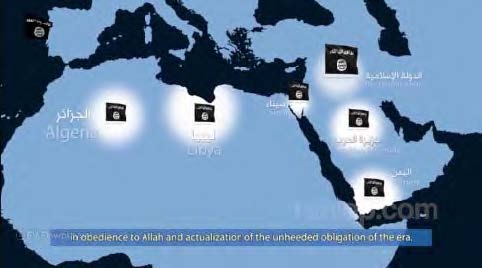
Map from an ISIS video showing the provinces it claims have sworn allegiance to Abu Bakr al-Baghdadi: Algeria, Libya, Yemen and Saudi Arabia (Reblop.com, November 17, 2014.
In Lebanon ISIS acquired operational capabilities and from its strongholds in Syria it initiates attacks against the Lebanese army and Hezbollah, collaborating with other jihadi organizations (the Al-Nusra Front among them). In other Arab countries, Jordan for example, ISIS is supported by local followers but so far they have not established contacts with it or sworn oaths of allegiance to its al-Baghdadi.
The increase in ISIS’s strength in the Arab countries, especially those surrounding Israel, has potential threats for anti-Israeli terrorism (although currently the jihadists direct their campaign against internal enemies). The Egyptian Ansar Bayt al-Maqdis is a concrete threat for Israel and in the past has been involved in attacking it (including rocket fire targeting Eilat, Israel’s southernmost city, and attacks along the Israel-Egypt border).
In the West, veterans of the conflict in Syria who fought in ISIS’s ranks are liable to initiate terrorist attacks in their countries of origin, such as the terrorist attack at the Jewish Museum in Brussels. ISIS may also inspire its supporters around the globe to carry out terrorist attacks without helping or directing them, but they may result from ISIS’s public incitement to kill Westerners (See below). Such attacks may be carried out by veterans of the fighting in Syria who have returned to their countries of origin, at the initiative of local jihadists or local jihadi networks. It is possible that the stabbing and vehicular attacks in Canada, the planned beheadings in Australia and the attacks and planned attacks in other Western countries were ISIS-inspired.
At this point it does not seem that carrying terrorist attacks abroad is ISIS’s top strategic priority. That is because ISIS is currently waging a campaign to extend its influence and control in Iraq and Syria, and at the same time is under attack from America and its allies. However, a continuation of the attacks may encourage ISIS to initiate sporadic terrorist attacks against Western and/or Israeli and Jewish targets beyond the borders of Iraq and Syria in retaliation for the aerial attacks or as a means of punishment and deterrence.
Historical background: exporting terrorism from Iraq under Abu Musab al-Zarqawi and his heirs
The export of terrorism and subversion beyond Iraq’s border began with Abu Musab al-Zarqawi, who joined Al-Qaeda in October 2004 and established the branch of Al-Qaeda in Iraq. Al-Zawahiri’s concept was focusing his terrorist activity in Iraq, the new “land of jihad,” as a replacement for his base in Afghanistan lost following the American attacks and the fall of the Taliban[78] Nevertheless, al-Zarqawi carried out sporadic terrorist attacks beyond the borders of Iraq although their priority was secondary and involved the limited investment of resources.
The terrorist attacks al-Zarqawi carried out before and after the American invasion of Iraq included the following: the assassination of the US Agency for International Development (USAID) official Lawrence Foley in Amman in October 2002; planning attacks for a network operating under the name al-Tawhid, thwarted in Germany in 2003; operating terrorist networks in Turkey and the Caucasus; the attempted suicide bombing attack in Jordan in April 2004;[79] and the three coordinated suicide bombing attacks on hotels in Amman, Jordan, on November 9, 2005, which killed 67 dead and wounded about 200.
Under Al-Zarqawi’s heir, Abu Hamza al-Muhajir, the branch of Al-Qaeda in Iraq dispatched suicide bombing attacks and car bombs beyond the borders of Iraq. However, even then suicide bombing attacks were not high on the organization’s priorities because it was focusing on fighting the forces of the Americans and their allies in Iraq.
Foreign fighters in the ranks of ISIS
Overview
ISIS and the other jihadi organizations regard the foreign fighters who join their ranks as particularly important, a pattern of behavior which has deep Islamic roots. That is because ISIS urgently needs to reinforce its ranks with fighters from other countries (an Al-Qaeda legacy) and because of ideological considerations. Abu Muhammad al-Julani, the leader of the jihadi Al-Nusra Front, recently described the ideological importance of foreign fighters by saying, “We are of the opinion that a jihadi group has to have an ’emigrant [i.e., foreign] fighter.’[80] He adds the dimension of the [Islamic] nation and distances the dimension of the [local] country or battle zone. That is an important principle, a Sunni principle, that must be preserved…” (Al-Manara al-Baydhaa’, November 4, 2014).
Foreign fighters are potentially dangerous to their countries of origin as “carriers” of terrorism and subversion. If they survive the fighting in Syria and Iraq, they return with military experience and jihadi indoctrination. At least some of them aspire to continue jihad against their countries of origin, whether for ideological reasons or to support the jihadi organizations fighting the United States and the West.

Encouraging foreign fighters to join the jihad. An ISIS propaganda video in Arabic and German called “Let us join the jihad.” It was produced by ISIS’s Al-Hayat Media Center (June 16, 2014).
The potential danger the veterans of the fighting in Syria and Iraq pose to their countries of origin was well illustrated by the shooting attack at the Jewish Museum in Brussels in May 2014. It was carried out by a French terrorist operative who had fought in the ranks of ISIS in Syria. He did it apparently on his own initiative without external direction. It was also illustrated by the exposure of ISIS-affiliated operatives in Australia, who planned to randomly behead people on the street in Sydney (See below). Both cases, which have no relation to one another, demonstrate the need to act more effectively against the terrorist dangers of Syrian and Iraqi veterans.
The Western countries are aware of the dangers and have begun to gather intelligence, prevent attacks and pass necessary legislation to improve the oversight of foreign fighters who go to Syria and Iraq and of those who return. Efforts have also been made to improve international cooperation to overcome the difficulties involved in monitoring foreign fighters. Such activity was legitimized by the UN Security Council and can be expected to increase in view of the anti-ISIS campaign declared by the United States.
In the wake of the West’s counterterrorism efforts, ISIS instituted security measures regarding the recruitment of foreign fighters. According to information from Islamic leaders in London, ISIS sent new instructions to Westerners wanting to join its ranks. They included the demand for a recommendation from at least one sheikh known to the ISIS leadership; instructions to go to Syria wearing [Western] clothing that would hide their Muslim identity and not to take books of a religious nature; and not to tell their families they were joining the Islamic State until they were in Syria and had undergone basic training (Aawsat.net, November 9, 2014).
Estimated number of foreign fighters in the ranks of ISIS
Updated to November 2014, in ITIC assessment there are an estimated 13,000 foreign fighter in the ranks of ISIS, of a total of approximately 25,000.[81] Of them, in ITIC assessment about 10,000 fighters come from Arab-Muslim countries and about 3,000 from the West. In addition, several thousand have already returned to their countries of origin.
The number of foreign fighters in the ranks of ISIS has grown significantly in the second half of 2014, since its military successes in Iraq and the declaration of the Caliphate. During the first half of 2014 ISIS had an estimated 7,000-8,000 foreign fighters, 5,000 of whom came from the Arab-Muslim world,[82] and more than 2,000 from Western countries. Thus during a relatively short period, the number almost doubled.
In CIA assessment, more than 15,000 foreign fighters from 80 countries went to Syria to join the ranks of ISIS. At least 2,000 of them came from the West (@DenverNicks, September 12, 2014). According to the American State Department, dozens of Americans are known to be fighting in the ranks of ISIS, of the more than 100 American citizens who wanted to join rebel organizations in Syria. On September 24, 2014, President Obama gave a speech in which repeated the statistics, saying the American intelligence organizations estimated that more than 15,000 foreign fighters from more than 86 countries had been in Syria in recent years. Many of them, he said, had joined organizations such as the Al-Nusra Front and ISIS.
The distribution of foreign fighters between ISIS and the Al-Nusra Front is unclear. In ITIC assessment, during the past year ISIS has channeled most of the foreign fighters to itself and they have sworn allegiance to Abu Bakr al-Baghdadi. Some of them are new arrivals and some are operatives who defected from the Al-Nusra Front or other organizations and joined ISIS. Apparently they join because of ISIS’s military successes, its large financial and military resources, the ideological attraction of its extremist positions, the pull of the idea of establishing a new Islamic Caliphate State and the fact that it is the main jihadi organization confronting the United States, the West in general and the socalled “infidel” Arab regimes.
France and Britain — largest Western countries of origin of foreign fighters
The number of Western foreign fighters is currently estimated at 3,000, almost half of them from France and Britain, which send ISIS and other global jihad organizations more foreign fighters than any other country.
French Foreign Minister Bernard Cazeneuve reported that approximately 930 French citizens were either fighting in the ranks of ISIS in Syria and Iraq or planning to join the organization. Among them were 60 women. So far, 36 Frenchmen have been killed fighting in the ranks of ISIS. Following intelligence information, the French authorities prevented at least 70 citizens from potentially leaving France for ISIS (Le Journal de Dimanche, September 14, 2014). British Prime Minister David Cameron told the UN General Assembly that 500 foreign fighters had arrived in Syria and Iraq from Britain (British Foreign Office website, September 24, 2014).
Randy Blake, a senior strategic advisor in the US Office of Director of National Intelligence, told a panel at the annual International Association of Chiefs of Police (IACP) in Orlando, Florida, that there were “about 16,000 foreign fighters who have traveled to Syria from over 80 countries.” He added that “roughly 2,000 of those fighters hail from Western countries — including “at least 500 from the U.K, 700 from France, 400 from Germany, and more than 100 Americans [who] have traveled, or tried to travel into Syria” (Nbcnews.com, October 29, 2014).[83]
The number of foreign fighters from France and Britain who joined ISIS and the Al-Nusra Front is significantly higher than their number at the beginning of 2014. The numbers have grown because of ISIS’s achievements and its increasing attractiveness, and may be an indication of the support for ISIS and the global jihad within the local Muslim communities in France and Britain. That poses dangers from terrorism and subversion to both countries, which are key partners in the American campaign against ISIS.
Foreign fighters in Iraq[84]
According to researcher Aaron Zelin, who monitors foreign fighters, they have gone to Iraq in two main waves:
- The first wave occurred following the entrance of the United States into Iraq (2003), when an estimated 4,000-5,000 foreign fighters arrived (mostly Saudis, Libyans, and Syrians). Many of them were killed in 2008 by American and Iraqi forces. Between 2008 and 2013 ISI underwent a process of “Iraqization,” due to the fact that the organization felt the Iraqis regarded it as a “foreign entity” because many of its commanders had come from other countries. As a result the number of foreign fighters in ISI’s ranks decreased greatly.
- The second wave began in 2014 following ISIS’s military successes and its establishing itself in Iraq and Syria. In addition, the border between Iraq and Syria gradually ceased to exist and foreign fighters could pass easily between the two countries. The rift between ISIS and the Al-Nusra Front increased the scale of defection of foreign fighters from the Al-Nusra Front to ISIS, the most prominent of whom was the above-mentioned Abu Omar al-Shishani. In addition, the release of more than 500 prisoners from Abu Ghraib and other Iraqi regime detention facilities helped ISIS increase the number of its fighters, many of whom were foreign fighters experienced in guerilla and terrorist warfare.
Aaron Zelin noted that since early March, the group had released 201 “martyrdom notices” for foreign fighters who died in Iraq. Most of them were from Arab states with significant representation from Tunisia, Saudi Arabia, Morocco, Syria and Libya. There were individual deaths from the Balkans, the Caucasus, Central Asia, the Horn of Africa, North America, and Western Europe. Among the eight Westerners represented, three were from Denmark, three from France, and one each from Canada and Norway. Based on the notices, the majority of foreign fighters killed in Iraq have fallen in the ISIS stronghold of Anbar (56 deaths), in parts of northern Baghdad province (51), and in Diyala province (41). The takeover of Mosul could increase the death toll in Nineveh province in the summer of 2014.
Using foreign fighters for suicide bombing attacks
ISIS customarily sends foreign fighters, both Arab-Muslims and Westerners, on suicide bombing missions in Syria and Iraq, a modus operandi ISIS specializes in. Foreign fighters are used because their religious zeal makes them suitable candidates for such attacks. However. ISIS also dispatches local Iraqis and Syrians to blow themselves up.
An example of ISIS’s handling of Western foreign fighters in Syria for suicide bombing attacks appeared in ISN, an ISIS English-language news magazine (See below). On June 5, 2014, ISN published the pictures (as quoted by The Shi’a Post, June 4, 2014[85]) of two suicide bombers who carried out attacks in Hama and Homs. They were a German suicide bomber nicknamed Othman al-Almani (“the German”), who blew himself up in Al-Kafaat, Hama; and a French suicide bomber nicknamed Abdulrahman al-Faransi (“the Frenchman”), who blew himself up in Al-‘Amad, Homs. Abdulrahman al-Faransi was Nicolas Bons, who appeared in a video as “Abu Abdulrahman,” in the company of his younger brother, who was killed in Syria in 2013 (MEMRI.org, June 21, 2014).[86]

Two Frenchmen who converted to Islam. One of them died in a suicide bombing attack in Homs (MEMRI.org, June 21, 2014).
Suicide bombers who carried out attacks in Iraq:
- On March 6, 2014, ISIS issued information about thirty suicide bombers who carried out attacks in the region of Baghdad. They were carried out between September 11, 2013 and March 6, 2014. Foreign fighters were also involved: seven suicide bombers were Moroccans (nicknamed “al-Maghrebi”), three were Egyptians, one was Uzbekistani and one was either Pakistani or Afghani (nicknamed “al-Khorasani”).
- On April 12, 2014, ISIS used its Twitter account to issue information about 26 suicide bombers, 24 of whom were foreign fighters, who carried out attacks in the Diyala province of Iraq. They were carried out between September 2012 and March 2014. Ten of the suicide bombers were from Tunis (and bore the nickname “al-Tunisi”) and others were from Saudi Arabia, Morocco, Iran, Tajikistan, Chechnya and Denmark. The origin of two other was not known (Longwarjournal.org).
Suicide bombers who died in Iraq
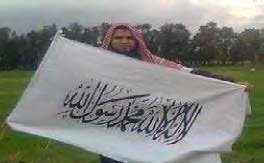
Abd al-Rauf al-Saadawi, aka Abu Dajana al-Tunisi, carried out a suicide bombing attack in the Shi’ite Madinat al-Sadr neighborhood of Baghdad on March 7, 2012.

Abu Ibrahim al-Masri carried out a suicide bombing attack against the Iraqi army in Al-Hamidiyah in Al-Anbar province on May 4, 2014 (Longwarjournal.org)
Apprehension of a French terrorist operative sent by ISIS to carry out a suicide bombing attack in Lebanon: Fayez Yussuf Boushran, 24, a French operative, whose interrogation revealed he had contacted a jihadist on Facebook and after being recommended went to Germany and from there to Turkey and then Syria. In Syria he joined ISIS and underwent twenty days of military training and religious indoctrination. ISIS sent him to Beirut where he was given an explosive belt which he was supposed to use to blow himself up in the Shi’ite-dominated southern suburb of Beirut. While waiting at his hotel for instructions he was apprehended in a raid carried out by the Lebanese Internal Security Forces’ Information Branch (AFP.com, November 7, 2014; Zawya.com, November 8, 2014).
Illustration of the threats posed by foreign fighters: the terrorist attack on the Jewish Museum in Brussels as a case study
On May 24, 2014, there was a shooting attack at the Jewish Museum in Brussels. The terrorist operative was a Frenchman who had fought in Syria in the ranks of ISIS; he shot four people to death in the attack. It was the first illustration of the dangers inherent to Western countries in general and France in particular, posed by the return of the jihadist Syrian veterans. The attack was apparently an individual initiative, possibly with the support of jihadi elements in Europe, but without external direction from ISIS.
The suspected terrorist, Mehdi Nemmouche, was a French Muslim from a family of Algerian origin. He grew up in Roubaix, an economically depressed industrial city in northeastern France. He had a criminal record. He joined ISIS in January 2013 (in the first wave of French foreign fighters who went to Syria) and after several months returned to France through Germany. Among the items found in his possession were the weapon he used to carry out the attack and a piece of cloth bearing the ISIS insignia.
Mehdi Nemmouche fits the profile of European foreign fighters in general and the French foreign fighters in particular who join the ranks of jihad organizations Syria and Iraq.[87] Nicolas Hénin, a French correspondent held captive by ISIS in Syria and later released, said that for a certain period of time he had been held with other Western captives, including two American correspondents, who had been executed. He said Mehdi Nemmouche was one of his captors and that he had tortured him (Telegraph.co.uk, September 7, 2014).[88]

Mehdi Nemmouche, a French Muslim who fought in Syria in the ranks of ISIS, suspected of the shooting in the Jewish Museum in Brussels (Twitter/@G_deLinares)
ISIS activity in Lebanon
Overview
ISIS began establishing itself in Lebanon in 2013 within Sunni population centers hostile to Hezbollah and the Lebanese administration. Its main support base (and that of other global jihad organizations) is the Sunni town of Arsal, north of Baalbek on the Syrian border. Global jihad organizations and networks also receive support in the northern city of Tripoli and in the Akkar province in northern Lebanon on the Syrian border.
Lebanon is an exceptional case in the Arab world, because unlike in other Arab countries, in Lebanon ISIS and the Al-Nusra Front collaborate. They acquired operational capabilities that allow them to attack Hezbollah with suicide bombing attacks. In addition, ISIS and the Al-Nusra Front support local operatives fighting a long-term campaign against the Lebanese army and Hezbollah in the Beqa’a Valley and recently in Tripoli as well. Their operations in Lebanon are meant not only to strengthen the global jihad’s penetration of the country but also to weaken Hezbollah, which (with support and direction from Iran) fights the global jihad organizations in Syria.
At this stage the jihad organizations in Syria are engaged in fighting Hezbollah and the Lebanese army. In the future, when they have gained a sufficient foothold, they may try to attack Israel from Lebanon, firing rockets and infiltrating terrorist squads into Israeli territory.
Fighting in the Beqa’a Valley
Arsal (northeast of Baalbek) is a power base for the jihadi organizations in Lebanon. It is a large Sunni Muslim town which had a population of 40,000 before the Syrian civil war. Since the war began almost four years ago it has taken in an estimated 80,000 Syrian refugees (Now.mmedia.me/lb, August 17, 2014). During the first half of August 2014 Arsal became a battlefield, with the Lebanese army fighting hundreds of armed operatives who had crossed the border with Syria, mainly from the city of Homs, the Al-Qalamoun region and the camps of the displaced Syrians in Lebanon (Aawsat.net, August 17, 2014). Among the armed operatives were fighters from ISIS and other jihadi organizations supported by organizations in Syria. After a week of fierce fighting the Lebanese army regained control of Arsal and some of the armed operatives returned to Syria.
Forty-four armed Syrian fighters and 15 local residents died in the battles in Arsal, and dozens of Lebanese army soldiers and members of the Gendarmerie were taken prisoner. ISIS operatives threatened to kill the captive soldiers unless the Lebanese government met their demands and released a large number of prisoners. In fact, during September 2014 ISIS did kill captive Lebanese soldiers and issued videos documenting the executions.
On November 5, 2014, sources with access to the Lebanese administration reported that jihadi organizations were holding 24 captives: 17 were held by the Al-Nusra Front and seven by ISIS. ISIS also had the bodies of two soldiers (Al-Akhbar.com, November 7, 2014). The jihadi organizations (led by the Al-Nusra Front) and the Lebanese government are negotiating for their release. ISIS demands the release of 22 jihadist prisoners imprisoned in Lebanon (MTV, Lebanon, November 6, 2014).
The battles which took place in Arsal caused a great deal of damage, and some of the local residents left for Beirut or other locations in the Beqa’a Valley. The Lebanese army and government’s control over the town is still shaky. The hostility of the Sunni population to the Lebanese administration and Hezbollah, Arsal’s physical proximity to Syria and the strong ties between the jihadists on both sides of the border all make the city a security problem for Lebanon and a potential internal terrorist threat.
In October 2014 clashes were renewed in the Arsal region and in other locations in the Beqa’a Valley between the Lebanese army and Hezbollah on the one hand and ISIS, the Al-Nusra Front and possibly other rebel organizations on the other. In addition, at the end of October 2014 there were violent clashes between the Lebanese security forces and the jihadi organizations in the city of Tripoli and the Sunni Akkar province. Apparently the Lebanese army is finding it difficult to end the violence in the above regions.
Suicide bombing attacks in Beirut
In 2014 ISIS carried out and claimed responsibility for two suicide bombing attacks in Beirut.[89] The first was carried out on January 2, 2014, in the Shi’ite southern suburb of Beirut near some of Hezbollah’s central institutions. The second was a mass-killing attack that went wrong, carried out on June 25, 2014, at Le Duroy Hotel and wounded 11 people. The achievements of the Syrian army and Hezbollah in the Qalamoun mountains (including the takeover of the city of Yabrud on March 15 and 16, 2014) and Hezbollah’s preventive activities against ISIS weakened ISIS’s capabilities and apparently disrupted their intentions to carry out other terrorist attacks in Lebanon.[90] However, confrontations in the Qalamoun mountains have not yet ended and the region may still be a source of terrorist attacks in Lebanon.
The cooperation between ISIS and Ansar Bayt al-Maqdis in Egypt
Overview
During October and the beginning of November 2014 ISIS expressed support for the Egyptian jihadi Ansar Bayt al-Maqdis, which heads the terrorist campaign currently being waged against the Egyptian regime. Its most prominent attack was carried out on October 24, 2014, at the Karam al-Qawadis military base near Sheikh Zuweid in the northeastern Sinai Peninsula, killing 33 Egyptian soldiers. ISIS issued strategic and operative “advice” for Ansar Bayt al-Maqdis and jihadi operatives in Egypt, encouraging them to escalate their terrorist campaign against the Egyptian regime and to move it to the center of Cairo.
On November 10, 2014, Ansar Bayt al-Maqdis said in an announcement that it had sworn allegiance to ISIS leader Abu Bakr al-Baghdadi, and had joined his self-declared Islamic State.[91] Three days later Ansar Bayt al-Maqdis announced it had turned the Sinai Peninsula into the Sinai province of the Islamic State.
Ansar Bayt al-Maqdis’ explicit support for ISIS and its swearing allegiance to Abu Bakr al-Baghdadi mark a new closeness in their collaboration. In ITIC assessment, both organizations expect to profit from it:
- For ISIS, Ansar Bayt al-Maqdis’ oath of allegiance is an important regional precedent because it indicates its influence has gone beyond the Iraqi and Syrian borders and progressed to a central Middle Eastern state. That may increase Abu Bakr al-Baghdadi’s prestige and improve his status vis-à-vis Al-Qaeda and his rivals in Iraq and Syria, the Al-Nusra Front among them. Collaboration with Ansar Bayt al-Maqdis may also encourage other jihadi organizations in the Middle East and beyond, such as Libya, to take a stand in the dispute between Al-Qaeda and ISIS, and to join ISIS.
- For Ansar Bayt al-Maqdis, collaboration with ISIS provides it with strong external support in the terrorist campaign it is waging against the Egyptian regime. Ansar Bayt al-Maqdis prefers ISIS to Al-Qaeda apparently because of its image as a victorious organization with improved military and financial capabilities, and because of its appeal to jihadists as an organization standing in the front line in the fighting against the United States and the West.[92]
Strategic and operational “advice” given by ISIS to Ansar Bayt al-Maqdis
On November 4, 2014, an ISIS forum posted strategic and operational “advice” for the jihad fighters in Egypt about how to wage their terrorist campaign against the Egyptian regime, mainly by following the model of Iraq. Their basic position was that the jihadists should move the weight of their efforts from the Sinai Peninsula to Cairo and other large cities in Egypt to harm the Egyptian regime by damaging its economy (tourism, the Suez Canal and the gas pipelines). Emphasis was also placed on absorbing foreign jihad fighters and integrating them by exploiting their motivation to carry out suicide bombing attacks.
The main points of the “advice” given to Ansar Bayt al-Maqdis by Abu Musab al-Maqdisi, who may be a liaison between it and ISIS, were the following (Alplatformmedia, November 4, 2014):
- Strike the “enemy” (the Egyptian regime) in Cairo and the large cities: Move the battle to “central Cairo” and engage the regime there. That will turn the Sinai Peninsula into an area that apostates (“deserters of religion”) are not allowed to enter and a rear base for a continuing jihad [against the Egyptian regime]. Remember that the Egyptian regime is less affected by Egyptians killed in the Sinai Peninsula than by the attacks on the capital Cairo “and the bodies of its dogs scattered in the city.”
- Strike government institutions and officials: Carry out operations using silencers, and “reap” the soldiers of the enemy (the Egyptian government). Strike the provincial centers and security departments of the Ministry of the Interior, to “weaken its security grip on the country.” Use the example of the severe blows the Iraqi regime suffered in Baghdad and elsewhere in Iraq. Actions carried out against Iraqi government institutions kept Iraqi government officials from travelling in their official vehicles and wearing their uniforms.
- Absorb foreign fighters (“emigrants”): Jihad fighters in Egypt must absorb foreign fighters (“emigrants”), “because a jihadi arena cannot move forward without emigrants.” Their presence will fuel the operations “particularly since [the foreign fighters] want to carry out suicide bombings” (istishhad, death as a martyr for the sake of Allah). Take advantage of the current situation, when it is easy to enter Egypt, and consider that entering Egypt in the future will require “a tremendous effort.” Jihad fighters in Egypt should absorb the foreign fighters, deploy them in all provinces and send them on operations against Egyptian government institutions.
- Fan the flames of sectarian religious war: ISIS calls on jihad fighters in Egypt to strike Christians and Shi’ites (following the Iraq and Syria model). That is “because they are [religious] communities that cannot be trusted and no agreement can be reached with them. They are nothing but plunder that Allah will give you…”
- Strike Palestinian organizations in the Gaza Strip: ISIS calls on jihad fighters in the Sinai Peninsula, in particular Ansar Bayt al-Maqdis, to attack trucks carrying weapons, missiles and explosives from the Sinai Peninsula to the Palestinian organizations in the Gaza Strip. That is because “those weapons hurt Muslims more than Jews, since Hamas and its government have stolen the weapons of your brethren, the jihad fighters in Gaza.”[93] The Palestinian organizations in the Gaza Strip “do not guarantee security for the lives of the residents in Gaza, their religion and their jihad, and the saga of their betrayals […] is known to all.”
- Attack judges: Attack Egyptian judges, “since a large percentage of the judges in Egypt are Christians.” They have abandoned Islam, tried many young Islamists and sentenced them to death or life imprisonment. “Killing judges is one means to serve our prisoners in the jails of the tyrants.”
- Strike at the economy: Strike at the Egyptian economy, “which allows the tyrannical and criminal government to fight Allah and his messenger.” In addition, “most of the Egyptian wealthy and decision-makers are also Christians.” Target the tourism industry, the gas pipeline to Israel and “to the countries of the tyrants” [i.e., Jordan], the economic institutions of the [Egyptian] army and the commercial areas in the Suez Canal. The revenue from the canal is used by El-Sisi “to move missiles and weapons to fight our brothers in Syria and to support tyrants like him.” In addition, “the fire of jihad should reach Sharm el-Sheikh” to end the prostitution and entertainment that Jewish and foreign tourists have enjoyed there.”
- Slaughter enemies and spies, do not shoot them: Jihad fighters should cut the throats of every spy and every one who has been proven to belong to the Egyptian state security forces or to collaborate with the Egyptian military establishment.[94]
The role of Israel
Israel was not mentioned in the “advice” ISIS had for Ansar Bayt al-Maqdis, probably because it is more concerned with fighting its domestic enemies (in this case the Egyptian regime). However, in the oath Ansar Bayt al-Maqdis swore to Abu Bakr al-Baghdadi on November 10, 2014, the “war against the Jews” was given prominence: “After decades…Allah ordered the flag of jihad to be raised in our land and gave us the honor of being the soldiers [Allah] chose to fight the nation’s most bitter enemies…the Jews. We struck them hard with many raids, such as Umm Rashrash (i.e., Eilat) and others…Our swords will be extended against them until Allah is victorious.” That seems to indicate Ansar Bayt al-Maqdis’ intention to include attacks on Israel in its campaign against the Egyptian regime, although Egypt is still its first priority.
Ansar Bayt al-Maqdis changes its name to the Sinai province of the Islamic State
On November 13, 2014, Ansar Bayt al-Maqdis changed its name to the “Sinai province of the Islamic State.” According to ISIS’s geographical divisions of the Islamic State, or Caliphate State, is divided onto various provinces (wilayat). Thus for ISIS the Sinai Peninsula has formally become one of its provinces, the first beyond the borders of the Islamic State in Iraq and Syria.
On November 14, 2014, the day after Ansar Bayt al-Maqdis’ name change, the “Sinai province” issued a video in which it claimed responsibility for the October 24, 2014 attack at Karam al-Qawadis near Sheikh Zuweid in which 33 Egyptian soldiers were killed (the worst terrorist attack since the security situation in the Sinai Peninsula began to deteriorate).[95] The speaker wears an ISIS shirt and the Arabic in the background reads, “Sinai province — Information bureau.” There is also a picture of a fighter standing on an Egyptian tank during the attack and waving an ISIS flag. On November 13, 2014, two videos were posted to YouTube claiming responsibility for the November 12, 2014 attack on an Egyptian navy vessel. Responsibility was claimed in the name of the soldiers of the Islamic State in the Land of Egypt.

Video posted to YouTube claiming responsibility for the terrorist attack killing 33 Egyptian soldiers. Left: The speaker claims responsibility; the Arabic reads “Sinai province — Information bureau.” Right: An operative from “the Sinai province of the Islamic State” (the Ansar Bayt al-Maqdis’ new name) stands on an Egyptian tank and waves an ISIS flag during the terrorist attack (YouTube)

Notices posted on the Islamic State website. Left: A soldier, perhaps Egyptian, shot by an attack helicopter. The Arabic reads, “Jihad cavalry, defenders of Sinai’s honor: Allah aimed your fire, strengthened you and allowed you (to take hold of) the necks of the Jews and their tails (a veiled reference to the Sisi regime). You are the heroes of jihad, the descendants of the sahaba (Muhammad’s faithful comrades).” Right: ISIS fighters going into battle. The Arabic reads, “There are men in Sinai who are heroes, they are like lions, they do not fear any dictator (a reference to Sisi) or any Jew. Allah, help them and make (their victory) possible, strengthen them and enlist everything you have (for their sake)” (Alplatformmedia.com).
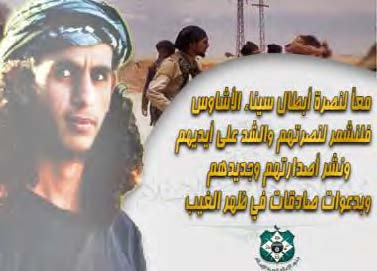
An Ansar Bayt al-Maqdis operative who blew himself up in the Security Directorate in the southern Sinai Peninsula on October 7, 2013.[96] The Arabic at the right reads, “Together (we will go) to support the heroes of Sinai — We will strive to support them and reinforce them, spread their announcements and every new thing (about them). We pray a prayer of truth for the sake of those who are not with us today (i.e., those who died)” (Alplatformmedia.com; Dawshagya.org).
Support and solidarity with ISIS in other Arab states and entities
Jordan
Support in Jordan for the Salafist-jihadi worldview is not new; it began in the 1990s. Jordan was the birthplace of Abu Musab al-Zarqawi, founder of the branch of Al-Qaeda in Iraq which eventually became ISIS. Support in Jordan increased following the Syrian civil war and ISIS’s military successes.
Most of Jordan’s support for ISIS comes from the outlying regions. Most prominent is the southern Jordanian city of Ma’an, a site of traditional unrest and anti-Hashemite sentiment, but there are other cities as well, among them Al-Salt, Irbid, Al-Rusaifa and Al-Zarqa’. Support increased with the return of veterans from Syria (in ITIC assessment, more than 1,000 Jordanians went to fight in Syria) and in the wake of ISIS media campaigns aimed at its Jordanian target audience. Nevertheless, apparently ISIS does not yet have an organized network of Jordanian fighters, although the potential for an increase in ISIS’s presence in Jordan does exist.
Support for ISIS was shown in Amman on June 20, 2014, after the Friday prayers when dozens of supporters held a pro-ISIS march. They carried signs and waved ISIS flags, and called for the Sykes-Picot borders of 1916 to be demolished — one of the main tenets of ISIS’s ideology. On August 21, 2014, a demonstration was held in the northern Jordanian province of Zarqa’, where ISIS flags were waved and support for Abu Bakr al-Baghdadi was voiced.
On September 30, 2014, CNN aired a report about the increase of support for ISIS in Ma’an, showing graffiti on walls in the city. They read, “Abu Bakr al-Baghdadi is our leader” and “The Islamic State will prevail.” A CNN correspondent said it was not hard to find ISIS supporters in the markets who voiced the opinion that the model of the Islamic State would solve all humanity’s problems.
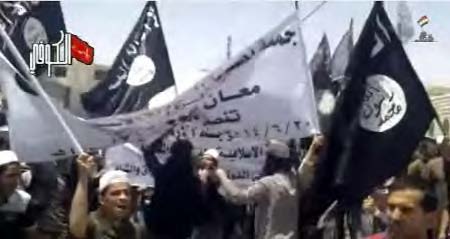
March held in support of ISIS in the city of Ma’an in southern Jordan on June 20, 2014 (YouTube, June 2014).
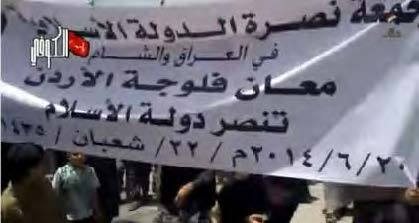
Banner supporting ISIS carried by demonstrators in Ma’an. The Arabic reads, “Friday (for the sake of) supporting ISIS. Ma’an is Jordan’s Fallujah. The Islamic State will be victorious. June 20, 2014” (YouTube, June 2014).
Issam al-Barqawi, aka Abu Muhammad al-Maqdisi, is a prominent Jordanian Salafist-jihadist who supports the Al-Nusra Front and strongly opposes ISIS. In June 2014 he was released from prison after serving a four-year sentence for involvement in terrorism. The Jordanians apparently released him to strengthen ISIS’s Salafist-jihadi rivals to divide and conquer. In public statements after his release al-Maqdisi claimed that the [self-] declaration of the Caliphate State threatened to divide Muslims, and called ISIS’s position an “aberration.” He condemned the military attacks of the West (“Crusaders”) on ISIS, but added that they were the result of ISIS’s oppression of the Muslims in Syria and the distortion of the legacy of Muhammad. He also called for the release of the British captive ISIS had threatened to put to death, claiming that those who entered Muslim lands had to be defended and could not be harmed (Al-Sabil, Jordan, September 19, 2014).
The preventive measures of Jordanian security
During ISIS’s years of activity in Iraq and during the first two years of its establishing itself in Syria, the Jordanian regime apparently did not regard it as a serious security threat. Therefore its security services did not take effective steps to prevent the flow of Jordanian foreign fighters to Syria and their return to Jordan.
Jordan’s attitude changed after ISIS’s achievements in the summer of 2014. The authorities began taking steps against Salafist-jihadists in Jordan who supported ISIS and to a lesser degree, against those who supported the Al-Nusra Front:
- On September 4, 2014, it was reported that more than 70 senior jihadists were detained in a number of cities and regions throughout the kingdom (Al-Salt, Irbid, Al-Zarqa’, al-Rusaifa, Ma’an and the northern Jordan Valley).
- On September 21, 2014, the Jordanian News Agency reported that the security services had detained 11 operatives affiliated with ISIS. According to the report, the operatives confessed they had connections with senior ISIS figures in Syria and that they had been planning to carry out terrorist attacks against “a number of vital interests” in Jordan. The house of one of the operatives, who lived in the northern part of the kingdom, blew up while explosives were being manufactured.
Solidarity and support for ISIS in the Gaza Strip[97]
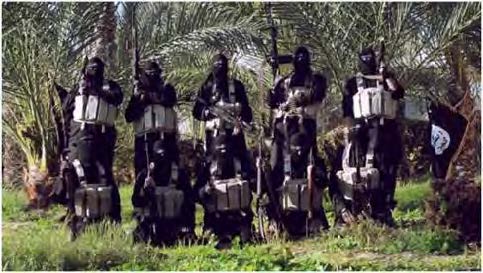
Armed, masked Salafist-jihadi operatives in the Gaza Strip express their loyalty to ISIS in a video posted to websites (Al-Quds, February 12, 2014)
There is support for ISIS in the Gaza Strip from Salafist-jihadists who were influenced by its achievements. They held a rally in Rafah and posted a video to YouTube. In addition, there are close to 40 Gazan operatives in Syria, some of them in a separate unit named for Sheikh Abu Nur al-Maqdisi (a Salafist-jihadi Gazan sheikh killed by Hamas in 2009 after he declared the establishment of the Islamic Emirate of Palestine).
During Operation Protective Edge Salafist-jihadi networks in the Gaza Strip publicly affiliated with ISIS launched rockets into Israel a number of times, and posted a video documenting the attacks where the ISIS flag could be seen. In addition, at least two Salafist-jihadists were killed during IDF attacks. However, put in perspective, the importance of Salafist-jihadi activity during Operation Protective Edge was marginal.
Hamas considers Salafist-jihadi activity as potentially dangerous and a practical and ideological challenge to its control of the Gaza Strip. So far, the Salafist-jihadi network in the Gaza Strip does not present a significant threat to Hamas, which can suppress any operational or propaganda activity that goes beyond the limits it has set down. Hamas has countered expressions of support for ISIS with strong measures, even if it has not engaged in a general confrontation with the Salafist-jihadists.[98]
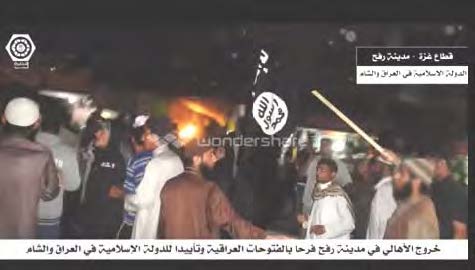
March in support of ISIS held by Salafist-jihadi operatives in Rafah; it was dispersed by the Hamas police force (YouTube, June 12, 2014).

Video documenting jihad operatives from the Gaza Strip in the ranks of ISIS firing 107 mm at Syrian army positions in Aleppo (YouTube, May 20, 2014).

Jihad operatives from the Gaza Strip from the Sheikh Abu al-Nur al-Maqdisi company fight in the ranks of ISIS in Syria (Twitter account of the jihad fighters from Syria in the ranks of ISIS, March 24, 2014).[99]
Libya
Many Arab foreign fighters who joined the ranks of ISIS came from Libya. Their number is estimated at between several hundred and close to a thousand. Some of the Libyan foreign fighters come from the eastern part of the country, especially from the coastal city of Darnah, which has a population of approximately 80,000. Qaddafi used to call it the “Islamic emirate” because it was a center for radical Islam during his regime.[100]
Some of the jihadists who returned to Darnah from Syria and Iraq set up a local jihadi organization called Majlis Shura Shabab al-Islam, headed by an emir named Muhammad Abdallah. They established courts which sentenced civilians accused of violating the precepts of sharia to be publicly executed. In June 2014 the organization announced its support for ISIS (Mobtada.com). At the beginning of November 2014 Majlis Shura Shabab al-Islam held a meeting in Darnah where it announced it was joining ISIS’s Islamic Caliphate, and swore allegiance to Caliph Abu Bakr al-Baghdadi (AP.org, November 9, 2014).
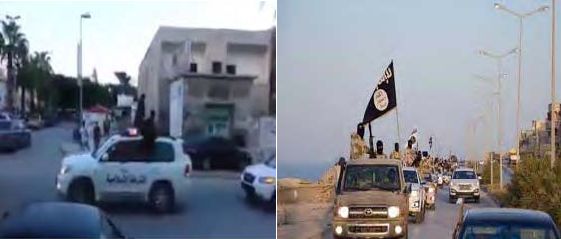
Left: From the video of a show of force held by the Majlis Shura Shabab al-Islam held in the city of Darnah in Libya on October 6, 2014. In the video the cars can be heard honking and there are cries of “Allahu Akbar.” On the side of the vehicle are the words “Islamic Police” (Alarabiya.net). Right: Majlis Shura Shabab al-Islam operatives in Darnah carry the ISIS flag (Mobtada.com).
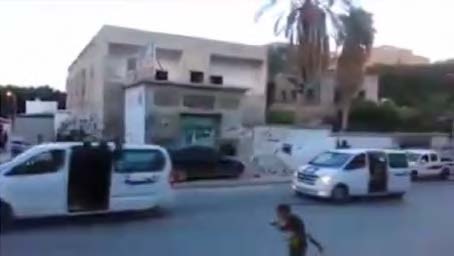
Two more Islamic Police vehicles in the October 6, 2014, Darnah cavalcade. On the side of the vehicles is the term al-hisbah, i.e., the name of ISIS’s modesty police (Alarabiya.net).
On November 12, 2014, Libyan airplanes of the military force of the secular government attacked the jihadi militia in Darnah. That came after a series of terrorist attacks carried out in Libyan cities controlled by the secular government.
Unlike those in Egypt, the Libyan jihadists who swore allegiance to ISIS belonged to a local, not national, jihadi network. The large Libyan jihadi organization Ansar al-Sharia and its allies fighting the secular Libyan government have so far not sworn allegiance to Abu Bakr al-Baghdadi.
Tunisia
There are many Tunisians among the foreign fighters joining ISIS and other organizations in Syria, and their numbers are estimated at more than 1,000. Hundreds of them have already returned to Tunisia.[101] One of the main organizations dispatching fighters to Syria has been a Salafist-jihadi organization called Ansar al-Sharia, affiliated with Al-Qaeda. It was established at the end of 2011 by a jihadist named Seif Allah bin Hussein, aka Abu Iyad al-Tunisi. Ansar al-Sharia operatives participated in protests held in Tunisia and were involved in riots and terrorist activities. In August 2013 the Tunisian government outlawed the organization.
On October 20, 2014, the Arabic media, relying on Tunisian intelligence sources, reported that an Ansar al-Sharia plan had been uncovered to establish an emirate in the southern part of the country which would swear allegiance to ISIS (Ar.webmanagercenter.com). On July 5, 2014 the organization expressed support for ISIS and its leader, Abu Bakr al-Baghdadi. According to information on an Arab Islamic website (which has not yet been verified), Ansar al-Sharia has already sworn allegiance to Abu Bakr al-Baghdadi (Islamic-movements.com, November 11, 2014).
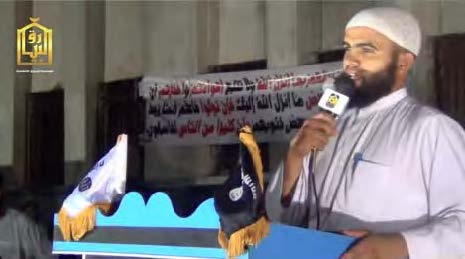
From a video posted to YouTube; an Ansar al-Sharia spokesman in Tunisia expresses support for ISIS; there is an ISIS flag on the podium at the right (YouTube, July 5, 2014).
Saudi Arabia
Saudi Arabia is one of the Arab countries with many foreign fighters in the ranks of ISIS in Syria. An updated estimate puts their number at about 1,400.[102]
On November 15, 2014 Abu Bakr al-Baghdadi issued a recorded statement in which he claimed the jihadi organizations in Saudi Arabia and Yemen had joined the Islamic State, and that Islamic State provinces had been established in both. So far it is unclear to which organizations or networks Abu Bakr al-Baghdadi was referring. In any event, Al-Qaeda in the Arabian Peninsula (AQAP), the branch of Al-Qaeda in Saudi Arabia and Yemen, the most important jihadi organization operating in the Arabian Peninsula, has not yet announced it has joined the Islamic State.[103]
Support and solidarity with ISIS in Asian states[104]
Following ISIS’s impressive successes and the declaration of the Islamic State, jihadi groups in Asian countries such as Pakistan, Afghanistan, India, the Philippines and Indonesia gradually manifested solidarity and support. Within the Salafist-jihadi groups and networks there are internal disputes over whether to affiliate with Al-Qaeda headquarters or ISIS. ISIS considers support from the Asian countries important and it encourages their foreign fighters to join its ranks, as can be seen from the videos and recorded messages it produces in Urdu.
The following are examples of Asian support for and solidarity with ISIS (MEMRI.org, September 18 and 25, 2014):
- Pakistan — A network called Tahreek-e-Khilafat wal-Jihad, which as been active in the Karachi region in recent years, became the first organization to bestow an oath of allegiance (bay’ah) on Abu Bakr al-Baghdadi after he declared the Islamic Caliphate. According to the oath, which was posted in Urdu on a Pakistani jihadi forum, as of now Abu Bakr al-Baghdadi is the Muslim Caliph and the men of Pakistan are one of the arrows on his bow. In addition, in October six Tahreek-e-Taliban Pakistan (TTP), including the organization’s spokesman, swore allegiance to Abu Bakr al-Baghdadi. However, Mulana Fazlullah, the organization’s leader, denied his organization belonged to ISIS.

Left: Pakistani supporters of ISIS. Right: Swearing allegiance to ISIS (MEMRI.org, September 10, 2014).
- Afghanistan — On October 25, 2014, a video about Abu Bakr al-Baghdadi and 5,000 of his fighters swearing allegiance to the Islamic State was posted on YouTube, a jihadi forum and the social networks. A masked operative speaking Arabic with an Afghan accent read a prepared statement to the effect that following disagreements within the Taliban he and his followers had sworn allegiance to Abu Bakr al-Baghdadi. He called on the Americans and the other “Crusaders” to stop their aerial attacks on ISIS, otherwise the mujahideen (jihad fighters) in Afghanistan would retaliate.
- India — Shortly after the Caliphate was declared Moulana Syed Salman Husaini Nadwi, an Indian Muslim cleric, sent an open letter congratulating Abu Bakr al-Baghdadi, referring to him as “the emir of the faithful.” In addition, in at least two instances in July 2014 during Operation Protective Edge, young men in Kashmir were seen waving ISIS flags in an anti-Israeli demonstration during Operation Protective Edge. The Indian media reported that during the first half of September 2014 the police had detained 15 engineering students from Hyderabad, one of them a young woman, who were en route to join ISIS (MEMRI.org, September 20, 2014).
- Indonesia — In May 2014 Al-Hayat, one of ISIS’s information branches, posted a video of a group of eight foreign fighters from Indonesia who had arrived in Iraq. One of them, nicknamed “Abu Ahmed the Indonesian,” urged other Indonesians to join ISIS and swear allegiance to al-Baghdadi.
- Philippines — According to the President Aquino, at least 100 young Filipino Muslims have gone to Iraq. Some of them belonged to Al-Jamaa’ Al-
Islamiyya, a jihadi organization operating in the eastern part of the country. On August 14, 2014, according to a notice posted on a jihadi forum by the jihadi organization Abu Sayyaf, it had changed its name to the “Organization of the Supporters of the Caliphate in the Philippines,” and had sworn allegiance to Abu Bakr al-Baghdadi.
Dozens of Israeli Arabs who joined ISIS and manifestations of support among Israeli Arabs
Overview
The Syrian civil war has been closely followed by Israeli Arabs. Some of them have expressed support for the Assad regime while other have demonstrated against “the crimes of the Syrian regime” and collected donations for the Syrian people. Thus the call to wage jihad against the Assad regime fell on attentive ears, especially among those who adopted with Salafist-jihadi ideology. In effect, most of the Israeli Arabs who go to Syria have a Salafist-jihadi background. Some are students who were exposed to Salafist-jihadi ideology during their studies in Jordan or Europe or by liaison operatives of the global jihad organizations operating in Syria. Finding a religious-ideological arena in which to fight made it possible for them to fulfill their dreams of jihad, which was impossible in the local Israeli arena (Shabak.gov.il, November 9, 2014).
Israeli Arabs began joining the ranks of the Syrian rebels in November 2012. At the beginning of 2014 their numbers were estimated as at least 20.[105] Since then, as in Western countries, their numbers have increased and today are estimated at 40. Four are known to have been killed in battle. Some returned to Israel and have been prosecuted (Shabak.gov.il, November 9, 2014).
Compared with Western Europe and the Arab countries, only a relatively small number of Israeli Arabs have gone to Syria and Iraq and joined ISIS and the other Salafist-jihadi organizations. So far no network established and directed by ISIS has been exposed among Israeli Arabs. However, the number of Israeli foreign fighters is gradually increasing and creates a potential security risk. While in Syria they receive military training and experience, and are indoctrinated with Salafist-jihadi ideology. In addition, they meet Al-Qaeda and global jihad operatives who may attempt to convince them to carry out terrorist and intelligence-collecting missions once they return to Israel, and they may also spread Salafist-jihadi ideology among Israeli Arabs.
The Israeli Arab foreign fighters are young, most of them in their twenties, and come from the Galilee, in central Israel and the south. The Internet plays an important role in recruiting and sending them to Syria. They arrive there individually or in small groups. Before they went to Syria the majority had led devout Muslim lives In most cases their going surprised their families.
The Israeli Arab foreign fighters enter Syria through Turkey, as do most of the other foreign fighters. They join the ranks of the rebel organizations, especially the jihadist organizations, while a few join the Syrian army (two cases are known). It is impossible to determine the distribution of Israeli Arab foreign fighters among the various factions, but apparently during 2014 ISIS became the most attractive.
Legislation and enforcement
Israeli Arabs’ joining ISIS and other jihadi organizations potentially endangers Israel’s security. The dangers were evident in the indictment brought against Ahmed Imad Shourbaji, 23, an Israeli Arab from the city of Umm el-Fahm, who was found guilty of joining ISIS in mid-September 2014. According to the charges (ITIC translation):
“There is a genuine danger posed by Israeli citizens or residents who go to Syria to join the rebels in fighting the Syrian regime. That is because in Syria they receive ideological and military training which may be exploited for terrorist activity against Israel. It may also be exploited to spread an ideology that preaches extremist Salafist-jihadi activities in Israel…[ISIS] operatives [in Syria] may also encourage them to carry out actions against the State of Israel. In addition, there is a genuine danger that jihadi operatives [in Syria] will extract strategic and tactical information about Israel from their contacts with Israeli [Arabs]… Thus they present a genuine threat to the security of the State of Israel.
To act more efficiently to prevent Israeli Arabs from going to Syria to join ISIS, on September 3, 2014, Israeli Minister of Defense Moshe Yaalon signed an order outlawing ISIS, having become convinced it was “necessary for the defense of the State of Israel and public safety and order…” The order made it possible to take legal action against networks, raising funds, and activities connected with ISIS, including against those who leave Israel to fight in its ranks. On October 27, 2014, the Knesset Legislative Commission unanimously passed a proposal for a bill that would allow Israelis who joined terrorist organizations operating in foreign countries, such as ISIS, to be prosecuted, even if the organizations were not actively engaged in attacking Israel (Haaretz.co.il, October 27, 2014).
According to Israeli Minister of Justice Tzipi Livni, every country has the right to defend itself, and Israel is no exception. An Israeli citizen who joins a terrorist organization motivated by radical Islamic ideology will be prosecuted. Legislation is an internal activity, but it is important that it be accompanied by external processes that create a common alliance with Western and Arab states targeting fundamentalist Islamist terrorism (Haaretz.co.il, October 27, 2014).
Sporadic expressions of support for ISIS from Israeli Arabs
In recent months there have been sporadic expressions of support for ISIS from Israeli Arabs, although there is apparently no proof that an organized, established network exists among them. For example, Israel Channel 10 interviewed an Israeli Arab from Nazareth who said he supported ISIS, the ISIS flag was flown from a mosque in Umm el-Fahm and dozens of ISIS flags were found in a garbage dump near Nazareth. On October 25, 2014, “ISIS” was spray painted on a wall of the soccer field in the Druze village of Daliat al-Carmel (south of Haifa), and on November 21, 2014, “ISIS” was spray painted on the town’s memorial monument to the Druze soldiers who fell while serving in the IDF.
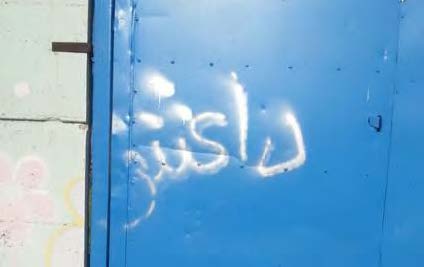
Graffiti found at a soccer field in the Druze village of Daliat al-Carmel (Israel Police Force spokesman, October 25, 2014). On November 23, 2014, graffiti were found in the village on the memorial monument of the Druze who fell while serving in the IDF.
On September 29, 2014, the Israeli security forces detained a 24 year-old teacher from Kafr Qara in central Israel on suspicion of supporting ISIS ideology. A search of his house revealed propaganda material, ISIS flags, videos and books about jihad. During interrogation he said he had brought the materials from Jordan (Facebook page of the Israel Police Force, September 29, 2014).
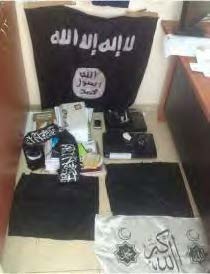
ISIS flags and other materials found in the possession of an Israeli Arab from Kafr Qara (Facebook page of the Israel Police Force, September 29, 2014).
Such expressions of support are met with opposition and rejections by the Islamic Movement, affiliated with the Muslim Brotherhood ideology. The Northern Branch of the Islamic Movement in Israel held a rally in Umm el-Fahm, where Sheikh Ra’ed Salah, the movement leader, said that ISIS’s activity was inappropriate for Islam and its objective was to harm the image of Islam and Muslims. He noted the commitment of the Islamic Movement to the anti-ISIS position formulated by the International Union of Muslin Scholars. However, he also expressed opposition to the coalition formed by the United States for the war against ISIS, which was, he said, “a danger to the Arab world” (Ynetnews.co.il, September 12, 2014).
Updated reports of Israeli Arabs who joined ISIS and other jihadi organizations in Syria
Overview
In September and October 2014 the Israeli and Arab media reported on Israeli Arabs (some of whom died in Syria and Iraq) who joined the ranks of ISIS and other jihadi organizations. Some updated examples are the following:[106]
Rabi’ Shahade from Nazareth
In September 2014 the London-based newspaper Al-Rai Al-Youm reported that at the beginning of 2014 Rabi’ Shahade, an Israeli Arab from Nazareth, 25 years old and married, had left his family and job in Tel Aviv and gone to Syria to join the ranks of ISIS. He posted a video on YouTube using the nickname Abu Musab al-Safuri (his family came from the village of Safuria) in which he called for Arabs to join the jihad in Syria. In a different video, posted in May 2014, he said, “We are a people who love to die for the sake of Allah while you love life. We love to drink your blood.” A friend standing next to him called him “the Palestinian slaughterer.”
Interviewed in Syria by the Al-Arab website, he said that for many years he had yearned to join the jihad in Syria. He said ISIS was defending Muslims and members of other religions, and that its objective in Syria was not limited to overthrowing the Assad regime, but to establishing an Islamic State that would be ruled according to the laws of Islam (Raialyoum.com, September 12, 2014). He posted a picture of himself on his Facebook page, showing him with another ISIS fighter (Facebook page of Abu Musab al-Safuri, September 15, 2014).

Left: Rabi’ Shahade from Nazareth issues a call from Syria for others to join him in jihad; behind him is the ISIS flag (YouTube, September 20, 2014). Right: Rabi’ Shahade interviewed in Syria (Arabnet5.com, September 2014).
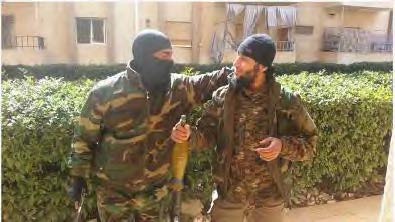
Rabi’ Shahade aka Abu Musab al-Safuri at the right. He posted the picture on his Facebook page, September 15, 2014.
Indictment of Ahmed Shourbaji, who fought in the ranks of ISIS and returned to Israel
In mid-September 2014 a court in Haifa indicted Ahmed Shourbaji for having joined ISIS. He was 23 years old and lived in Umm el-Fahm. According to the indictment,
- On January 14, 2014, Ahmed Shourbaji and three of his friends left for Syria via Turkey to join the rebel forces (the others were Rabi’ Shahade, Ahmed Habashi and Muhammad Jabarin).
- The four infiltrated into Syria with the help of smugglers and joined a rebel unit called Jaish Muhammad, where they underwent a week of training.
- About a week later the four were recruited by ISIS, where Shourbaji operated for about three months until he returned to Israel on April 20, 2014.
- While in the ranks of ISIS he spend a week in a training camp and received religious instruction to “strengthen his fighting spirit.” Most of his training involved the use of light arms (Kalashnikov assault rifles, RPG launchers, machine guns, hand grenades).
- While in Syria he fought in several battles, firing his weapon. He was also posted at roadblocks and went on patrol.
- On April 20, 2014, he returned to Israel, landed at Ben-Gurion international airport and was detained by the Israeli authorities. The friends he left with have not yet returned. When he joined ISIS he gave the organization his Israeli passport, which was not returned.
In sentencing Ahmed Shourbaji, the court adopted the State’s position that joining ISIS was a serious security felony. According to the court, leaving Israel for military training in an enemy country in general and Syria in particular and in the ranks of ISIS was a security felony with great potential danger for Israel’s security (Haaretz.co.il, September 24, 2014). Ahmed Shourbaji was sentenced to 22 months in prison for illegal training in a terrorist organization operating in Iraq and Syria. According to the indictment, Israeli citizens or residents who go to fight in Syria in the ranks of the rebels under the aegis of jihadi organizations pose a genuine threat to the country. That is because the training they receive in Syria can be exploited for terrorist activity against t the State of Israel, and presents a clear and present danger to the security of the country (Maariv.co.il, November 3, 2014).
Four young men from Yafia go to Syria to join the ranks of the rebels
The Israeli media and a local newspaper published in Nazareth reported that four young men from Yafia, a town near Nazareth, left the country during Eid al-Adha (the Feast of the Sacrifice) and went to Turkey with the intention of joining the ranks of the rebels or the Islamic State (i.e., ISIS). One of them changed his mind and returned home. The remaining three crossed the border into Syria and since then their families have not heard from them (Haaretz.co.il, October 13, 2014).
Friends of the three said that they had led devout Muslim lives. They had used the social networks to contact elements encouraging Muslims with suitable ideological motivation to enlist in jihadi organizations. On October 24, 2014, one of them, Hamza Sami Sari Magamsa, along with two friends, underwent training at an ISIS camp in Syria (News1.co.il, November 24, 2014).
The death of Ahmed Muhammad al-Habashi from the village of Iqsal while he fought in the ranks of ISIS in Iraq
The Arabic and Israeli media reported that Ahmed Muhammad al-Habashi, a young Israeli Arab who had joined ISIS, was killed in battle in Iraq during the first half of October 2014. His family is from the village of Iqsal near Nazareth. They said that at the beginning of 2014 he left Israel with four friends. They assumed he and his friends had crossed the border into Syria and joined ISIS. They were told he had died, apparently killed in the region of Ramadi in Al-Anbar province in Western Iraq (Haaretz.co.il, October 12, 2014).
Israeli Bedouin join ISIS
Othman Abu al-Kiyan, 26 years old, from the Bedouin village of Houra in the Negev, left the country with a relative named Shafiq Abd al-Kiyan to join ISIS. Othman Abu al-Kiyan was killed in Syria at the beginning of September 2014 while fighting in the ranks of ISIS. He studied medicine at Irbid University in Jordan, graduated in May 2014 and was interning at the Barzilai Medical Center in Ashqelon in the south of Israel (Haaretz.co.il, September 20, 2014). According to the Israeli media, Othman Abu al-Kiyan was the second al-Kiyan family member killed in Syria. Another, who was a teacher, was also killed fighting in the ranks of ISIS (Nana10.co.il, November 4, 2014).
Idris Abd al-Kiyan, brother of Othman Abu al-Kiyan, lives in Houra and is a Salafist-jihadist. He helped Othman and Shafiq finance and coordinate their trip to Syria. He was charged with conspiring to commit a felony and supporting an illegal departure from Israel (Shabak.gov.il, November 9, 2014). The Israeli media reported that during interrogation he confessed he knew about Othman and Shafiq’s intention to go to Syria and helped them coordinate their trip via Turkey. He also gave them money to pay for the trip and provided them with information about local residents who could help them. According to his interrogation, he used the social networks to conduct most of his contacts with terrorist operatives (Israelnationalnews.com, May 27, 2014).
![]()
[1] Links to all other nine sections:
You can read the overview — “ISIS: Portrait of a Jihadi Terrorist Organization” — here.
You can read section 1 — “The historical roots and stages in the development of ISIS” — here.
You can read section 2 — “ISIS’s ideology and vision, and their implementation” — here.
You can read section 3 — “ISIS’s military achievements in Iraq in the summer of 2014 and the establishment of its governmental systems” — here.
You can read section 4 — “ISIS establishes itself in eastern and northern Syria” — here.
You can read section 5 — “ISIS’s capabilities: the number of its operatives, control system, military strength, leadership, allies and financial capabilities” — here.
You can read section 7 — “ISIS’s propaganda machine” — here.
You can read section 8 — “The American campaign against ISIS” — here.
You can read section 9 — “ISIS response to the American campaign (update to mid-November 2014)” — here.
![]()
Notes:
[77] In a recorded message Abu Bakr al-Baghdadi posted to YouTube on November 15, 2014, he announced the spread of the Islamic State to Saudi Arabia, Yemen, Egypt, Libya and Algeria. He claimed the names of local jihadi organizations had been abolished and they were now affiliated with the new Islamic State provinces that has been established and to which provincial governors had been assigned. In Egypt and eastern Libya that occurred in actual practice.
[78] Schweitzer and Goldstein-Ferber, p. 80.
[79] Ibid., p. 79.
[80] The “emigrants” (muhajirin) — In Islam, the term Al-Muhajirin refers to the first Muslims, who emigrated with the Prophet Muhammad from Mecca to Medina, and were among his first core of supporters. The foreign fighters in Syria and Iraq are represented as being like the first Muslims who trail blazed the spread of Islam.
[81] Al-Nusra Front leader Abu Muhammad al-Julani recently referred to the ratio of foreign to local fighters in his organization. He claimed that before the dispute between the Al-Nusra Front and ISIS about 70% of his operatives were foreign fighters (whom he referred to as “emigrants”). After the dispute their numbers fell. Today about 40% of the senior operatives in the Al-Nusra Front are foreign fighters. He said they made up between 30% and 35% of the rank and file (recorded interview with Abu Muhammad al-Julani produced by the Al-Nusra Front’s information arm, Al-Manara al-Baydhaa’, November 4, 2014).
[82] For further information about foreign fighters from the Arab-Muslim world, see the May 13, 2014 bulletin “The Phenomenon of Foreign Fighters from the Arab World in the Syrian Civil War.” It is a continuation of the ITIC studies on foreign fighters from Asia (April 2014) and the Arab countries (January 2014).
[84] This section is based on the analysis and data provided by Aaron Zelin (Washingtoninstitute.org, June 12, 2014). washingtoninstitute.org.
[86] For further information about foreign fighters as suicide bombers in Syria, see the February 11, 2014 bulletin “Using suicide bombers as weapons: The leading modus operandi in the Al-Nusra Front and Islamic State in Iraq and Greater Syria’s struggle against the Syrian regime and Hezbollah in Lebanon.”
[87] For further information see the June 10, 2014 bulletin “The terrorist suspected of carrying out the shooting attack at the Jewish Museum in Brussels has been identified as a French Muslim jihadist.”
[89] For further information about the suicide bombing attacks carried out by ISIS and the Al-Nusra Front in Lebanon see the February 11, 2014 bulletin “Using suicide bombers as weapons.”
[90] For further information see the April 10, 2014 bulletin “Hezbollah’s Involvement in the Civil War in Syria.”
[91] For further information see the November 12, 2014 bulletin “ISIS’s public support for the Egyptian jihadi organization Ansar Bayt al-Maqdis, encouraging it to escalate the campaign of terror against the Egyptian regime. In turn, Ansar Bayt al-Maqdis pledged allegiance to ISIS leader Abu Bakr al-Baghdadi.”
[92] On November 13, 2014, the Arab news site Al-Watan.com reported that an ISIS operative nicknamed Abu Omar al-Masri claimed that the Al-Qaeda leadership had warned Ansar Bayt al-Maqdis it would stop providing it with money and weapons. Al-Masri claimed that in the near future, when Ansar Bayt al-Maqdis operated in Cairo, ISIS would provide the organization with everything it needed.
[93] A reference to the decisive measures taken by the Hamas government against Salafist-jihadi organizations in the Gaza Strip in light of their potential challenge to its control.
[94] Ansar Bayt al-Maqdis, like ISIS, carries out public beheadings. On August 28, 2014, it posted a video documenting the beheading of four men who, according to the organization, collaborated with the Israeli Mossad. The operative who read the written announcement also executed the four men (Alarbiya.net).
[95] The speaker reads the following text: “…Here, in the proud land of Sinai, ranks were aligned, opinions were united and the path became clear — Jerusalem cannot be liberated until the land in Egypt is cleansed of collaborators: the soldiers of el-Sisi, the collaborators of the Jews.”
[96] A reference to the car bomb attack targeting the security administration in El-Tor in the southern Sinai Peninsula that killed three and wounded 62. The Ansar Bayt al-Maqdis claimed responsibility.
[97] For further information see the July 16, 2014 bulletin “Expressions of support in the Gaza Strip for the Islamic State in Iraq and Al-Sham (ISIS), which is affiliated with the global jihad.”
[98] For further information see the July 16, 2014 bulletin “Expressions of support in the Gaza Strip for the Islamic State in Iraq and Al-Sham (ISIS), which is affiliated with the global jihad.”
[99] Sheikh Abd al-Latif Khaled Muhammad Musa, aka Abd al-Nur al-Maqdisi, was a Salafist-jihadi sheikh who, until he was killed by Hamas, was the religious-ideological authority for the Salafist-jihadi operatives in the Gaza Strip. On August 14, 2014, he gave a sermon in the Ibn Taymiyyah Mosque in Rafah in which he declared the establishment of the Islamic Emirate in Palestine. Hamas considered the sermon a provocation and challenging its control of Gaza. Its forces broke into the mosque and engaged in an exchange of fire with the jihadi operatives who had barricaded themselves inside. During the clash, Hamas killed jihadists including Sheikh Abd al-Nur al-Maqdisi, who became a symbol for the jihadists in the Gaza Strip.
[100] For further information see the May 13, 2014 bulletin “The Phenomenon of Foreign Fighters from the Arab World in the Syrian Civil War.”
[101] For further information see the May 13, 2014 bulletin “The Phenomenon of Foreign Fighters from the Arab World in the Syrian Civil War.”
[102] Zelin, Jihadology.
[103] According to a Syrian opposition website, Al-Qaeda in the Arabian Peninsula (AQAP) posted a video attacking Abu Bakr al-Baghdadi for causing a split in the ranks of the global jihad fighters (Al-Harar Al-Shamiya, November 21, 2014).
[104] This section contains updated information. For further information see the April 15, 2014 bulletin “Foreign fighters from various countries and regions in Asia, fighting against the Syrian regime, most of them in organizations affiliated with Al-Qaeda and the global jihad.”
[105] For further information see the January 19, 2014 bulletin “Israeli Arabs and Palestinians Join the Ranks of the Rebels in Syria, Mainly Organizations Affiliated with Al-Qaeda and the Global Jihad.”
[106] For previous examples see the January 5, 2014 bulletin “Israeli Arabs and Palestinians Join the Ranks of the Rebels in Syria, Mainly Organizations Affiliated with Al-Qaeda and the Global Jihad.”



 RSS
RSS













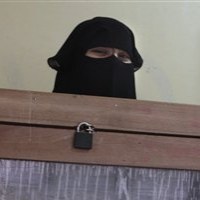
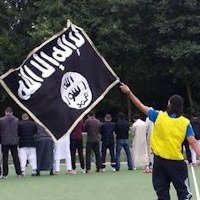
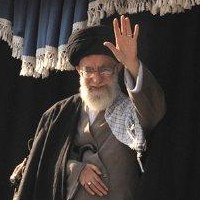





Latest Comments
Hello Mike, Thank you for your positive feedback to the article. I felt there wasn’t too much critical analysis of ...
Thanks for this considered and well constructed article. A follow up article on the manner in which the editorial contro...
THE CLUELESSNESS OF CLAIMING THAT OBAMA'S MIDDLE EAST POLICIES WERE A FAILURE CANNOT BE FURTHER FROM THE TRUTH, WHAT THE...
As long as Obama is the president of the usa do not trust the us government......
Thank you for an good read....